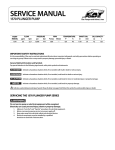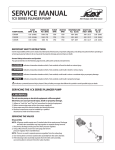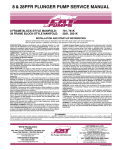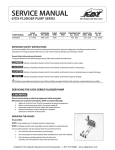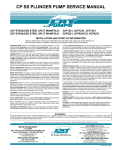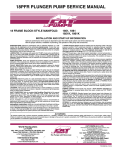Download SERVICE MANUAL
Transcript
SERVICE MANUAL 6810 PLUNGER PUMP PUMP MODEL 6810 FLOW gpm lpm 10.0 38 PRESSURE psi bar 10,000 689 RPM TEMPERATURE Pump Motor ˚F ˚C 600 — 140 60 SHAFT DIA. in mm 1.772 45 OIL CAPACITY oz l 320 9.46 IMPORTANT SAFETY INSTRUCTIONS It is the responsibility of the user to read and understand all instructions, important safeguards, and safety precautions before operating or servicing any pump. Failure to do so may result in property damage, personal injury or death. General Safety Information and Symbols Pay special attention to the following signal words, safety alert symbols and statements: DANGER indicates a hazardous situation which, if not avoided, will result in death or serious injury. WARNING indicates a hazardous situation which, if not avoided, could result in death or serious injury. CAUTION indicates a hazardous situation which, if not avoided, could result in minor or moderate injury or property damage. NOTICE indicates a hazardous situation which, if not avoided, could result in property damage. Indicates a potential personal injury hazard. Obey all safety messages that follow this symbol to avoid possible injury or death. SERVICING THE 6810 PLUNGER PUMP SERIES WARNING Do not service pump or electrical equipment while energized. Electricity can cause personal injury, death or property damage. 1. 2. 3. 4. Adhere to “Lock Out” and “Tag Out” procedures for electrical equipment. Before commencing pump service, turn power supply off. Keep water away from electrical outlets and electrical devices. Electrical components must be installed by a qualified electrician to avoid risk of electrocution. SERVICING THE VALVES Disassembly NOTE: Pump requires one (1) valve kit to repair pump. Valve kit includes discharge and inlet components. 1. Use a M14 Allen Wrench to remove two (2) M16 Hex Socket Head Screws (HSH) from opposite outside corners of Inlet Manifold/Discharge Manifold (IMDM). 2. As an aid in supporting the manifold, replace these two (2) screws with two (2) M10 x 180 threaded studs (PN 701268). 3. Use a M14 Allen Wrench to remove remaining four (4) M16 HSH screws from IMDM. 4. Grasp IMDM and pull away from pump. It may be necessary to use a rubber or plastic mallet to tap the backside of the IMDM to assist in removing from the pump. Figure 1 NOTE: The ball seat assemblies (discharge valves) and cylinder assemblies may remain in the IMDM or housing block (See Figure 1). 5. If ball seat assemblies remain in the IMDM, use two (2) flat tip screwdrivers on opposite sides and pry from IMDM. Using a seal pick, carefully remove sealing rings that may be on either side of the ball seat assemblies or in the IMDM. 6. If cylinder assemblies remain in the housing block, use two (2) flat screwdrivers on opposite sides and pry from housing block. 7. Remove the inlet valve, spring and spring retainer from each cylinder (See Figure 2 ). Reassembly 1. Install rear o-ring into each cylinder groove using a tacky grease to hold o-ring in groove. Install front o-ring into each cylinder groove. 2. Install cylinders into housing block. Apply a light coat of grease to each plunger and push the cylinder onto the plungers until the cylinders contact the housing block. Rotate cylinders so the cooling water holes are in the 4 and 11 o’clock position. Align marks on cylinder and housing block (See Figures 3 & 6). 3. Examine inlet valves, springs and spring retainers for wear and replace as needed. 4. Install springs onto spring retainers and push it to the shoulder of the spring retainers. 5. Insert grooved end of the inlet valves into springs. 6. Install completed inlet valve assemblies into each cylinder with inlet valve facing out. 7. Install sealing rings into cylinders with the radius facing out. 8. Examine ball assembly seat (inlet valve side) and balls for wear and replace if needed as a complete assembly. NOTE: Ball assembly seat comes complete with seat, ball and pin. 9. Install sealing rings into IMDM with the radius facing up. 10. Install ball assembly seats into the IMDM. The ball assembly seat should be installed so the inlet side with the eight small holes is facing up (See Figure 4 ). 11. Apply antiseize lubricate to threads of the six (6) M16 HSH screws. Install two of them into the center holes of the IMDM. 12. Slide IMDM over support studs and press IMDM up to the cylinder o-rings. Using a M14 Allen Wrench thread the two (2) screws into the housing block alternately until the IMDM is firmly against the cylinders. Remove two (2) support studs and insert the remaining screws by hand. Tighten the screws in an “X” pattern starting in the center and then move to the outside screws. Torque to 960 in-lbs, 80 ft-lbs or 108 Nm in the sequence as shown below. Figure 2 Figure 3 TORQUE SEQUENCE 5 4 1 2 3 6 Figure 4 2 SERVICING THE SEALS Disassembly NOTE: To service the seals it is necessary to remove the IMDM, discharge valves, inlet valves and cylinders. Follow steps 1 to 6 under SERVICING THE VALVES, Disassembly. 1. Remove the inlet valves, springs, and spring retainers from each cylinder. 2. Using a socket that fits inside the cylinder, drive the v-packing assembly out of each cylinder. 3. Remove sealing rings and o-rings from each cylinder. 4. Use a M14 Allen Wrench to remove two (2) M16 HSH screws from opposite outside corners of housing block. 5. As an aid in supporting the mainfold, replace these two (2) screws with two (2) M16X280 threaded studs (PN 88902). Figure 5 NOTICE Exercise extreme caution when removing housing block. The weight of the housing block or any twisting action can damage the ceramic plungers. 6. Use a M14 Allen Wrench to remove remaining six (6) M16 HSH Screws from housing block. 7. Grasp and support the housing block. Remove the housing block from the crankcase by sliding housing block over the plungers and threaded studs. 8. Using a flat screwdriver carefully remove the Lo-pressure seals from each seal chamber of housing block (See Figure 5 ). Reassembly 1. Inspect low pressure seals for wear and replace as necessary. Insert low pressure seal into seal chamber of housing block with spring is facing towards the IMDM. Seat the low pressure seal into the housing block. 2. Carefully slide the housing block over the ceramic plungers and place onto the pump guide pins. Install the six (6) M16 HSH screws using an M14 Allen Wrench. Remove two (2) threaded studs. Install remaining two (2) M16 HSH screws. Torque to 625 in-lbs, 52 ft-lbs or 70 Nm. 3. Place cylinder on a piece of hard wood or plastic with the larger diameter end up. Install sealing ring with the radius facing up. 4. Inspect the v-packing assembly for wear and replace if necessary. Insert v-packing assembly into cylinder so one of the slots is aligned with the two water cooling holes in the cylinder. Drive v-packing assembly into the cylinder using a rubber or plastic mallet. 5. Install rear o-ring into each cylinder groove using a tacky grease to hold o-ring in groove. Install front o-ring into each cylinder groove. Install cylinders into housing block. Apply a light coat of grease to each plunger and push the cylinder onto the plungers until the cylinders contact the housing block. Rotate cylinders so the cooling water holes are in the 4 and 11 o’clock position. (Align marks on cylinder and housing block as shown in Figure 6). 6. Install inlet valve spring onto each spring retainer and push it to the shoulder of the retainer. Insert grooved end of the inlet valve into the spring. Insert inlet valve assembly into each cylinder. 7. Install sealing ring into each cylinder with the radius facing out. 8. Install sealing rings into IMDM with the radius facing up. Install the ball assembly seats into the IMDM. The ball assembly seats should be installed so the inlet side with the eight small holes are facing up. 9. As an aid in supporting the IMDM, hand thread (2) M16X280 threaded studs (PN 88902) into the opposite corners of the inner bolt pattern of the housing block. 10. Apply anti-galling grease to the six (6) M16 HSH screws. Install two of them into the center holes of the IMDM. Install the IMDM up to the cylinder o-rings. Using an M14 Allen Wrench thread the two screws into the housing block alternately until the IMDM is firmly against the cylinders. Remove two (2) threaded studs. Insert the remaining screws by hand. Tighten the screws in an “X” pattern starting in the center and then move to the outside screws. Torque in steps to a final torque of 960 in-lbs, 80 ft-lbs or 108 Nm in the sequence as shown on page 2. Figure 6 3 SERVICING THE PLUNGERS Disassembly 1. 2. 3. Servicing the plungers must be done by removing the IMDM and housing block. Follow steps 1 to 6 under SERVICING THE VALVES , Disassembly to remove IMDM. Follow steps 4 to 7 under SERVICING THE SEALS, Disassembly to remove housing block. Use a 21 mm wrench to remove plungers from plunger rods. Remove barrier slingers on plunger rods. Reassembly 1. 2. 3. 4. Install barrier slingers on plunger rods. Clean and inspect the plungers for wear and replace if necessary. Apply a light coat of Loctite® 242® to plunger rod threads and stud threads. Install plungers to plunger rods. Using a 21 mm wrench tighten plungers to approximately 180 in lbs, 15 ft lbs or 20 Nm. Follow steps 2, 5, 9 and 10 under SERVICING THE SEALS, Reassembly to re-install housing block and IMDM. Loctite and 242 are registered trademarks of Henkel Corporation. PREVENTATIVE MAINTENANCE CHECK-LIST Check Clean Filters Oil Level/Quality Oil Leaks Water Leaks Plumbing Initial Oil Change Oil Change Seal Change Valve Change Accessories Daily Weekly 50 hrs. 500 hrs. * 1,000 hrs. ** X X X X X X X X X X * If other than Cat Pumps special custom blend, ISO 68 hydraulic oil is used, change cycle should be every 300 hours. ** E ach system’s maintenance cycle will be exclusive. If system performance decreases, check immediately. If no wear at 1000 hours, check again at 1500 hours and each 500 hours until wear is observed. Valves typically require changing every other seal change. Duty cycle, temperature, quality of pumped liquid and inlet feed conditions all effect the life of pump wear parts and service cycle. ** R emember to service the regulator at each seal servicing and check all system accessories and connections before resuming operation. 4 Figure 7 GENERAL SAFETY INFORMATION AND SYMBOLS DANGER A. FLAMMABLE OR EXPLOSIVE LIQUID HAZARD Do not operate pump with flammable or explosive liquids unless extraordinary safety precautions are observed. Leaks of flammable or explosive liquids, if exposed to elevated temperatures, static electricity, sparks or other hazards, will result in flame or possible explosion, causing serious personal injury, death or property damage. 1. Before operating pump with flammable or explosive liquids, ensure proper maintenance has been performed. 2. Do not operate pump with flammable or explosive liquids if leaks are detected. 3. O nly pump flammable or explosive liquids that are compatible with pump component materials. 4. Do not operate pump with flammable or explosive liquids without safeguards or safety systems to detect leaks, elevated temperatures, spark prevention or any other hazards defined by the NFPA systems. 5. Do not remove Flammable Liquids Product Suitability Hang Tag to assure proper safety. 6. Follow ATEX guidelines for potentially explosive atmospheres. WARNING A. ELECTRICAL SHOCK HAZARD Do not service pump or electrical equipment while energized. Electricity can cause personal injury, death or property damage. 1. Adhere to “Lock Out” and “Tag Out” procedures for electrical equipment. 2. Before commencing pump service, turn power supply off. 3. Keep water away from electrical outlets and electrical devices. 4. Electrical components must be installed by a qualified electrician to avoid risk of electrocution. B. ROTATING PARTS HAZARD Do not service pump while energized. Moving, rotating or reciprocating parts can crush and cut, causing personal injury, death or property damage. 1. Adhere to “Lock Out” and “Tag Out” procedures for electrical equipment. 2. B efore commencing pump service, turn power supply off, turn water supply off, squeeze trigger on gun to relieve system pressure. 3. For mobile equipment, be sure engines and hydraulics are turned off and secured to avoid accidental start. 4. Do not operate with safety guards removed. 5. Always use safety guards on all belt drives, couplings and shafts. C. HOT SURFACE HAZARD Do not touch pump, accessories or drive system while operating and until cool down is complete. Touching hot surface areas of the pump, accessories or drive system can cause severe burns or personal injury. D. SKIN PUNCTURE HAZARD Do not allow spray to contact any part of the body or animals. Pumped liquids under high pressure can pierce skin and underlying tissue or can deflect debris leading to serious personal injury or death. 1. Relieve all line pressure in the inlet line to the pump and discharge line from the pump before performing any maintenance on the pump. 2. W hen high pressure gun is not in use, set safety trigger lock (safety latch) to avoid accidental high pressure operation and personal injury or property damage. 3. Do not check for leaks with hand. Use a piece of cardboard to check for leaks. 4. Review cleaning procedures to minimize heavy back blasting. 5. Wear adequate safety equipment and clothing when operating high pressure sprayer. Never use high pressure spray with bare feet or exposed skin, and always wear safety glasses. E. PUMPING LIQUIDS HAZARD Do not operate pump with hot water, chemicals, or other hazardous liquids unless extraordinary safety precautions are observed. Pumping hot water, chemicals, or other hazardous liquids can expose personnel to serious injury. 1. Provide guards or shields around equipment to protect personnel. 2. Wear mask, goggles or eye protection while operating high pressure equipment. 3. Obtain a Material Safety Data Sheet (MSDS) or Safety Data Sheet (SDS) and take appropriate safety measures for the liquid being handled. 5 F. OVER PRESSURIZATION HAZARD Do not operate high pressure pumping system unless extraordinary safety precautions are observed. A high pressure pumping system can deadhead or over pressurize causing serious personal injury and property damage. 1. All high pressure systems require a primary pressure regulating device (i.e., regulator or unloader) and a secondary pressure safety relief device (i.e., pop-off valve, safety valve, rupture disc) to assure proper pressure setting and overpressure protection. 2. All high pressure systems require a pressure gauge to monitor pressure settings and avoid overpressure of equipment or personal harm. 3. Install primary pressure relief device on the discharge side of the pump. 4. Install secondary pressure relief device between the primary device and pump. 5. Install pressure gauge onto the discharge manifold or in the discharge line near the manifold. 6. Open all valves on discharge side of plumbing before operation. G. OXYGEN HAZARD Do not charge Prrrrr-O-Lators (Pulsation Dampeners) with Oxygen. Oxygen may cause an explosion causing personal injury, death or property damage. 1. Use Nitrogen only when charging pulsation dampeners, DO NOT USE OXYGEN. 2. Use proper charging tools to charge pulsation dampeners. 3. Charge pulsation dampener within specifications stated on data sheet to assure proper pulsation dampening and prevent failure of bladder. H. FALL HAZARD Do not operate pressure washer while standing on slippery or unstable surface unless extraordinary safety precautions are observed. Pressure washing may create slippery surface on which a person may slip and fall causing personal injury or death. 1. Wear suitable footwear to maintain a good grip on wet surfaces. 2. Do not stand on ladders or scaffolding. 3. Do not over reach or stand on unstable supports. 4. Keep good footing and balance and hold gun with both hands to control kick back. CAUTION A. IMPROPER USE OF FITTINGS HAZARD Do not operate the pump with improperly connected, sized, worn or loose fittings, pipes or hoses. Operating the pump under these conditions could result in personal injury and property damage. 1. Ensure all fittings, pipes and hoses are properly rated for the maximum pressure rating and flow of the pump. 2. Check all fittings and pipes for cracks or damaged threads. 3. Check all hoses for cuts, wear, leaks, kinks or collapse before each use. 4. Ensure all connections are tight and secure. 5. Use PTFE thread tape or pipe thread sealant (sparingly) to reconnect plumbing. Do not wrap tape beyond the last thread, this will prevent tape from becoming lodged in the pump or accessories. 6. Apply proper sealants to assure secure fit or easy disassembly when servicing. B. FROZEN LIQUID HAZARD Do not operate the pump with frozen liquid. Operating the pump under this condition could over pressurize and jettison the manifold from the crankcase causing personal injury and property damage. 1. Store pump or pumping system in an environmentally controlled room protected from freezing temperatures. 2. Follow procedures in TECH BULLETIN 083 to winterize pump. C. CLEANING PUMP HAZARD Do not use solvents that are flammable and toxic to clean or degrease equipment. Use of these solvents could result in personal injury and property damage. 1. Follow safety instructions as found in MSDS or SDS or on packaging of each liquid. 2. Clean equipment in a well ventilated area. 3. Disposal of solvents to be in accordance with local, state and federal regulations. D. OPERATING BEYOND SPECIFICATIONS HAZARD Do not operate the pump outside the specifications of individual pump data sheet or service manual. Operating the pump under these conditions could result in personal injury and property damage. 1. Do not operate the pump faster than the maximum recommended rpm. 2. Do not operate the pump at pressures higher than the maximum recommended pressure. 3. Do not operate the pump at temperatures higher than the maximum recommended temperatures. 4. Do not use accessories that are not compatible or rated for the pump. 6 E. LIFTING DEVICE HAZARD Do not lift pump with unsuitable lifting devices. Use of unsuitable lifting devices may cause pump to fall resulting in personal injury, damage to pump and/or pump with drive/base plate. 1. Lifting eyes installed on the pump must be used only to lift the pump. 2. S pecial lifting eyes should be installed on the base for lifting the pumping system (i.e. base, drive and accessories) 3. If slings or chains are used for lifting, they must be safely and securely attached to properly balance the weight of the unit. 4. Inspect slings and chains prior to use and replace worn and damaged slings and chains. NOTICE A. OIL HAZARD Use only genuine Cat Pumps custom-blend, premium grade, petroleum-based hydraulic oil. Use of other oil may not provide proper lubrication of drive-end components and may result in damage to the crankcase of the pump. 1. Cat Pumps custom-blend oil is available worldwide in 21 oz. bottles, cases, or 5 gallon twin packs. Use of other oils may void the warranty. 2. Fill pump crankcase to specific capacity indicated on data sheet or service manual prior to startup. B. ROTATION OF PUMP HAZARD Do not rotate pump crankshaft in reverse direction. Rotation of pump crankshaft in reverse direction may not provide proper lubrication and may result in damage to the drive-end components. 1. Forward rotation is the top of the crankshaft turning towards the manifold head of the pump. 2. Ensure oil is filled to the center red dot on sight gauge for forward rotation. 3. Ensure oil is filled to slightly above center red dot on sight gauge for reverse rotation. C. BELT TENSION HAZARD Do not operate pump with excessive belt tension. Excessive belt tension may damage the pumps bearings or reduce horsepower. 1. Rotate pump crankshaft before starting to ensure shaft and bearings are moving freely. 2. Ensure pulleys are properly sized. 3. Periodically replace belts to assure full horsepower transmission. 4. Ensure center distance dimensions between pulleys is correct. D. BY-PASS OPERATION HAZARD Do not operate the pump in by-pass for extended lengths of time. Operating the pump under this condition can quickly cause heat build-up resulting in damage to the pump. 1. Route by-pass line to supply reservoir to dissipate heated by-pass liquid into a large reservoir of cool water to reduce excessive temperature build-up. 2. R oute by-pass line to inlet of pump using a thermo valve in the by-pass line or auto shut-off assembly that will sense temperature rise and either by-pass or shut down system before damage occurs. E. DRY OPERATION HAZARD Do not operate the pump without water or liquid. Operating pump under these conditions could result in damage to the pump. 1. Open all valves on inlet side of pump before starting operation to prevent starving the pump. 2. Do not exceed inlet suction pressure limit specified in pump data sheet. 3. Ensure inlet feed exceeds the maximum flow being delivered by the pump. 4. Ensure all fittings, pipes and hoses are properly sized for the pump to avoid restricted flow. 5. Review and implement all other recommendations appropriate for your system from the Inlet Condition Check-List. 7 DIAGNOSIS AND MAINTENANCE One of the most important steps in a high pressure system is to establish a regular maintenance program. This will vary slightly with each system and is determined by various elements such as the duty cycle, the liquid being pumped, the actual specifications vs rated specifications of the pump, the ambient conditions, the inlet conditions and the accessories in the system. A careful review of the necessary inlet conditions and protection devices required before the system is installed will eliminate many potential problems. Cat Pumps are very easy pumps to service and require far less frequent service than most pumps. Typically, only common tools are required, making in-field service convenient, however, there are a few custom tools, special to certain models, that do simplify the process. This service manual is designed to assist you with the disassembly and reassembly of your pump. The following guide will assist in determining the cause and remedy to various operating conditions. You can also review our FAQ or SERVICE sections on our WEB SITE for more facts or contact Cat Pumps directly. PROBLEM PROBABLE CAUSE SOLUTION Low pressure • Worn nozzle. • Air leak in inlet plumbing. • Pressure gauge inoperative or not registering accurately. • Relief valve stuck, partially plugged or improperly adjusted. • Inlet suction strainer (filter) clogged or improperly sized. • Abrasives in pumped liquid. • Leaky discharge hose. • Inadequate liquid supply. • Severe cavitation. • Worn seals. • Worn or dirty inlet/discharge valves. • Replace with proper size nozzle. • Tighten fittings and hoses. Use PTFE liquid or tape. • Check with new gauge. Replace worn or damaged gauge. • Clean/adjust relief valve. Replace worn seats/valves and o-rings. • Clean filter. Use adequate size filter. Check more frequently. • Install proper filter. • Replace discharge hose with proper rating for system. • Pressurize inlet. • Check inlet conditions. • Install new seal kit. Increase frequency of service. • Clean inlet/discharge valves or install new valve kit. Pulsation Water leak • Under the manifold • Into the crankcase • Foreign material trapped in inlet/discharge valves. • Clean inlet/discharge valves or install new valve kit. • Worn V-Packings or Lo-Pressure Seals. • Humid air condensing into water inside the crankcase. • Excessive wear to V-Packings and Lo-Pressure seals. • Install new seal kit. Increase frequency of service. • Install new oil cap protector. Change oil every 3 months or 500 hours. • Install new seal kit. Increase frequency of service. Knocking noise • Inlet supply • Bearing • Inadequate inlet liquid supply. • Broken or worn bearing. • Check liquid supply. Increase line size or pressurize. • Replace bearing. Oil leak • Crankcase oil seal • Crankshaft oil seal and o-ring • Drain plug • Dip stick • Bearing cover • Filler cap • Worn crankcase oil seal. • Worn crankshaft oil seal or o-ring on bearing cover. • Loose drain plug or worn drain plug o-ring. • Loose dip stick or worn flat gasket. • Loose bearing cover or worn bearing cover o-ring. • Loose filler cap or excessive oil in crankcase. • Replace crankcase oil seal. • Remove bearing cover and replace o-ring and/or oil seal. • Tighten drain plug or replace o-ring. • Tighten dip stick or replace flat gasket. • Tighten bearing cover or replace o-ring. • Tighten filler cap. Fill crankcase to specified capacity. Pump runs extremely rough • Inlet conditions • Pump valves • Pump seals • Restricted inlet or air entering the inlet plumbing • Stuck inlet/discharge valves. • Leaking V-Packings or Lo-Pressure seals. • Correct inlet size plumbing. Check for air tight seal. • Clean out foreign material or install new valve kit. • Install new seal kit. Increase frequency of service. • Scored plunger. • Over pressure to inlet manifold. • Abrasive material in the liquid being pumped. • Excessive pressure and/or temperature of pumped liquid. • Running pump dry. • Starving pump of adequate liquid. • Eroded manifold. • Replace plunger. • Reduce inlet pressure per specifications. • Install proper filtration at pump inlet and clean regularly. • Check pressure and inlet liquid temperature. Premature seal failure • DO NOT RUN PUMP WITHOUT LIQUID. • Increase hose one size larger than inlet port size. • Replace manifold. Check liquid compatibility. CAT PUMPS 1681 - 94TH LANE N.E. MINNEAPOLIS, MN 55449-4324 PHONE (763) 780-5440 — FAX (763) 780-2958 e-mail: [email protected] www.catpumps.com For International Inquiries go to www.catpumps.com and navigate to the “Contact Us” link. PN 31399 Rev A 14038








